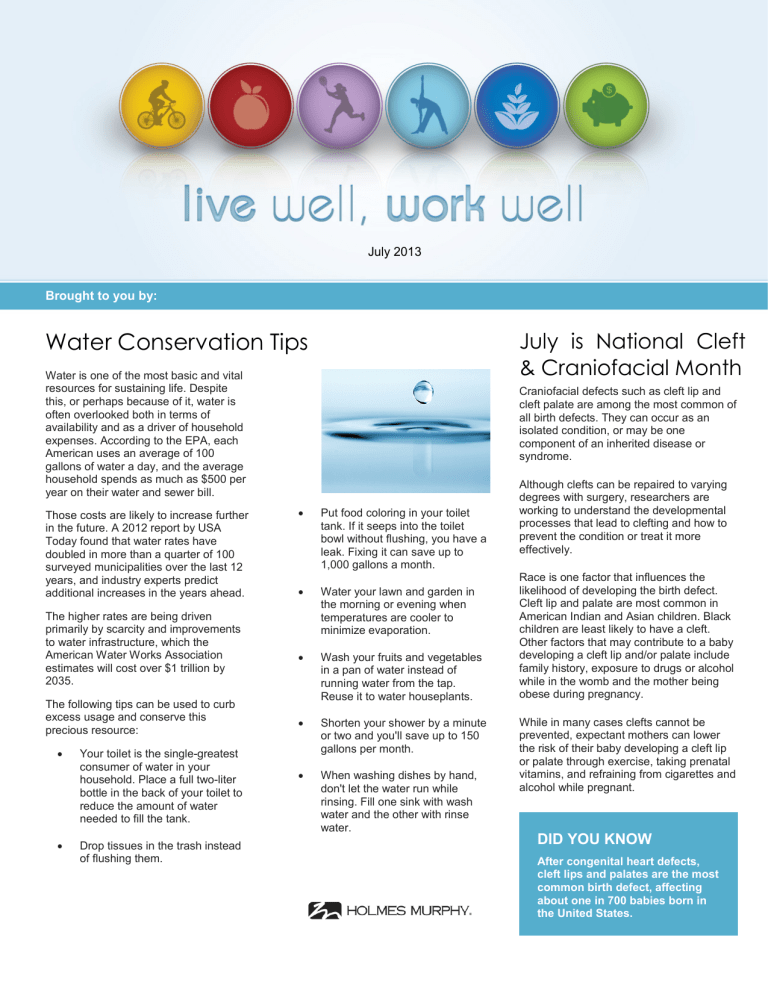Water Conservation Tips July is National Cleft & Craniofacial Month July 2013

July 2013
Brought to you by:
Water Conservation Tips
Water is one of the most basic and vital resources for sustaining life. Despite this, or perhaps because of it, water is often overlooked both in terms of availability and as a driver of household expenses. According to the EPA, each
American uses an average of 100 gallons of water a day, and the average household spends as much as $500 per year on their water and sewer bill.
Those costs are likely to increase further in the future. A 2012 report by USA
Today found that water rates have doubled in more than a quarter of 100 surveyed municipalities over the last 12 years, and industry experts predict additional increases in the years ahead.
The higher rates are being driven primarily by scarcity and improvements to water infrastructure, which the
American Water Works Association estimates will cost over $1 trillion by
2035.
The following tips can be used to curb excess usage and conserve this precious resource:
•
Your toilet is the single-greatest consumer of water in your household. Place a full two-liter bottle in the back of your toilet to reduce the amount of water needed to fill the tank.
•
Drop tissues in the trash instead of flushing them.
•
Put food coloring in your toilet tank. If it seeps into the toilet bowl without flushing, you have a leak. Fixing it can save up to
1,000 gallons a month.
•
Water your lawn and garden in the morning or evening when temperatures are cooler to minimize evaporation.
•
Wash your fruits and vegetables in a pan of water instead of running water from the tap.
Reuse it to water houseplants.
•
Shorten your shower by a minute or two and you'll save up to 150 gallons per month.
•
When washing dishes by hand, don't let the water run while rinsing. Fill one sink with wash water and the other with rinse water.
July is National Cleft
& Craniofacial Month
Craniofacial defects such as cleft lip and cleft palate are among the most common of all birth defects. They can occur as an isolated condition, or may be one component of an inherited disease or syndrome.
Although clefts can be repaired to varying degrees with surgery, researchers are working to understand the developmental processes that lead to clefting and how to prevent the condition or treat it more effectively.
Race is one factor that influences the likelihood of developing the birth defect.
Cleft lip and palate are most common in
American Indian and Asian children. Black children are least likely to have a cleft.
Other factors that may contribute to a baby developing a cleft lip and/or palate include family history, exposure to drugs or alcohol while in the womb and the mother being obese during pregnancy.
While in many cases clefts cannot be prevented, expectant mothers can lower the risk of their baby developing a cleft lip or palate through exercise, taking prenatal vitamins, and refraining from cigarettes and alcohol while pregnant.
DID YOU KNOW
After congenital heart defects, cleft lips and palates are the most common birth defect, affecting about one in 700 babies born in the United States.
Summer Exercise Safety Tips
While regular exercise is essential for good health, it’s only beneficial if done safely. Follow these precautions to eliminate the danger in warm weather workouts.
Stay hydrated.
Drink water before, during and after exercising.
Experts recommend drinking 20 ounces of water before exercising and eight ounces after finishing your work out, with water breaks every 15 to 20 minutes while exercising.
Choose the right clothing. Wear loose-fitting clothes to allow circulation of air between your skin and the environment.
Wear sunscreen.
Apply sunscreen with an SPF of at least 15 half an hour before exercising.
Moderate your pace.
If it’s hotter than usual, cut back on your pace or exposure time. Don’t try to set personal records during the hottest time of the year.
Grow Your Own Vegetable
Garden
Gardening might be the best hobby out there. Growing your own garden is a great way to be active, eat healthy and save money all at once. Whether you’re a novice or a seasoned gardener, here are some tips to help supercharge your growing power:
Keep it small. Start small so you don’t overwhelm yourself with gardening tasks and growing cycles, and also so you don’t end up wasting food by growing more than you need.
Grow for variety. Homogenous gardens are more susceptible to insects and disease than gardens with a variety of plants.
Keep in mind that vegetables such as tomatoes, peppers and squash keep providing throughout the season, but other vegetables, such as carrots, radishes and corn, produce only once.
Decide where to grow. The perfect spot for your garden will have good soil, be close to a source of water and receive six to eight hours of direct sunlight every day. This can be accomplished on a porch with a growbox or separate containers if you’re working without a yard. A well-tended 10-by-10 garden will usually produce more than a weed-filled or disease-ridden
25-by-50 bed.
Start composting. Compost piles provide excellent nutrients for your garden soil, and because they can be made of grass clippings or discarded fruits and vegetable material, they are completely free.
Make it visible. Keep your garden in a place where it will be seen. It’s easier to appreciate and remember that your garden needs tending if you plant next to your front porch, rather than tucked away somewhere in the backyard.
Couscous Salad
Couscous is made of tiny grains of pasta and is a staple of
North African cooking. It combines well with dried cherries in this high-fiber salad, which can be served as a great accompaniment to pork, lamb or poultry.
1 cup water
¾ cup couscous
½ cup dried tart cherries
½ cup coarsely chopped carrots
½ cup chopped cucumber
¼ cup sliced green onions
¼ cup toasted slivered almonds
3 tbsp. balsamic vinegar
1 tbsp. olive oil
1 tbsp. Dijon-style mustard
Salt and pepper to taste
In a medium saucepan, bring water to a boil. Add couscous and remove from heat. Let stand, covered, for 5 minutes before fluffing couscous with a fork. Put cooked couscous, dried cherries, carrots, cucumbers, green onions and almonds in a large mixing bowl and mix well. In a separate bowl, combine vinegar, olive oil and mustard; mix well. Pour over couscous, stirring to coat all ingredients. Season with salt and pepper.
Serve chilled or at room temperature.
Yield: 6 servings. Each serving provides 190 calories, 1g of fat,
0mg of cholesterol, 28mg of sodium and 9g of fiber.
Source: Michigan Department of Community Health
This brochure is for informational purposes only and is not intended as medical advice. For further information, please consult a medical professional.
© 2013 Zywave, Inc. All rights reserved.






